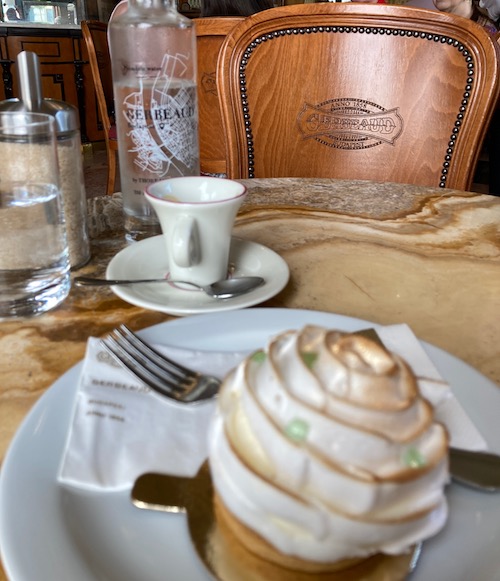
by Christina Waters | Jul 6, 2022 | Home |
In warm, humid, beautifully green Budapest, I stroll along the Danube before approaching 19th century interior of the lovely old Gerbeaud, a destination cafe and pastry shop in the heart of old town Budapest.
Here along with a juicy variety of mostly ladies who lunch, but the occasional Italian man, or table of German students with backpacks, I selected an opulent pastry from a display case of cakes, tortes, and strudels capable of inducing diabetes right on the spot. The interior, with its dark wood, chandeliers, and tall windows is straight out of Florence circa 1890.
The pastry looked like a Disney movie, but incredibly enough it was actually wonderful. Like a hyper-creamy cheesecake built on top of a disk of pastry crust with apricot puree embedded inside. Along with the world’s tiniest espresso, I ate almost the entire million calorie delight.
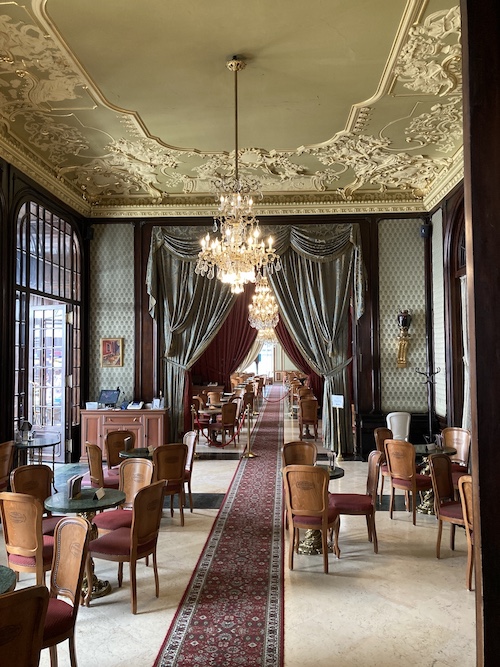
Nearby, along the pedestrian corridor with its herringbone and checkerboard walkways of cobblestones, were a handful of lively cafes including Anna Cafe, a place filled with locals and visitors from all over the world—mostly America, France, and Germany—all clamoring for beer, ice cream, and some of those slow-cooked Hungarian specialties.
 I too succumbed to an irresistible Chicken Paprikish with galuszkaval….little noodlelike dumplings. The dish arrived steaming hot, utterly delicious. Homey chicken stew liberally perfumed with paprika, and the noodles were the ultimate comfort food. The temperature in the shade was at least 85 degrees so my lunch was consumed with a large bottle of mineral water. The couple to my right worked their way through enormous bowls of ice cream, sauced with chocolate and fruit, and topped with whipped cream. Bowls the size of children’s wading pools. They finished everything.
I too succumbed to an irresistible Chicken Paprikish with galuszkaval….little noodlelike dumplings. The dish arrived steaming hot, utterly delicious. Homey chicken stew liberally perfumed with paprika, and the noodles were the ultimate comfort food. The temperature in the shade was at least 85 degrees so my lunch was consumed with a large bottle of mineral water. The couple to my right worked their way through enormous bowls of ice cream, sauced with chocolate and fruit, and topped with whipped cream. Bowls the size of children’s wading pools. They finished everything.
On my first evening in Budapest—the only one in which I would not be sitting in a long opera—I went downstairs to my hotel restaurant, which happened to have a Michelin star. Costes Downtown is sleek, minimalist, and smartly run by young staffers who speak excellent English. My fellow diners were from France, Germany, and England. [English was the default language everywhere in Budapest. Good thing, since Hungarian is known for being among the most difficult languages in the world, second only to Finnish.]
I tell the hostess I can’t possibly consume the eight (8) courses of the prix fixe dinner, so she smartly consults with the kitchen and offers me the four course lunch menu instead. Eager to sample the non-Tokay Hungarian wines, I opt for the wine pairing to go with the meal.
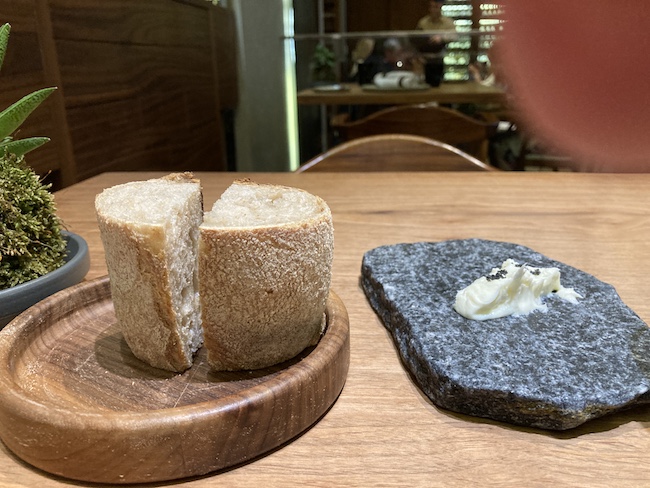 The courses, all wonderful, begin with delightful amuses. A warm kumquat arrives filled with pureed kumquat. A granita of citrus and Campari comes topped with carrot foam. A baby green leaf is flash fried. The bread is so good I could cry. An oat-based ciabatta, it arrives with a fist full of soft French butter that has been oak-smoked and topped with (so help me) Hawaiian charcoal. The effect is of a hint of smoke and intensely mineral/salt finish. This is bread that can actually hold its own with my fresh memories of French baguettes.
The courses, all wonderful, begin with delightful amuses. A warm kumquat arrives filled with pureed kumquat. A granita of citrus and Campari comes topped with carrot foam. A baby green leaf is flash fried. The bread is so good I could cry. An oat-based ciabatta, it arrives with a fist full of soft French butter that has been oak-smoked and topped with (so help me) Hawaiian charcoal. The effect is of a hint of smoke and intensely mineral/salt finish. This is bread that can actually hold its own with my fresh memories of French baguettes.
Next comes a square of house cured salmon topped with the surprise of sliced green strawberries and a glaze of ponzu sauce. Flavors that are fabulous together, yet who does such a pairing? I’m beginning to sense the chef’s modus operandi. The first wine arrives, a single vineyard white with a slight effervescence, salt and stone in the beginning, a fresh finish. Every dish that arrives comes on a different kind of plate or platform, from a slice of agate, to a marble bowl, to glazed stoneware, to porcelain. Wonderful.
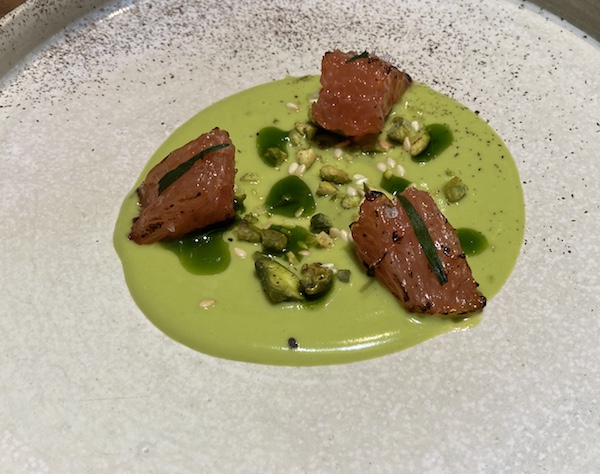 Another starter of grapefruit, with fresh tarragon on a shallow lake of pistachio cream is a surprise and a knock-out.
Another starter of grapefruit, with fresh tarragon on a shallow lake of pistachio cream is a surprise and a knock-out.
The second white wine has the sweet nose of botrytis, but a crisp finish to go with a dish of lightly cured rainbow trout with dashi and blackberries. The chef spent time in Vietnam and Tokyo, as well as in the kitchen of Ferran Adria, all of which inflects his tendency toward Asian accents.
 The main course of aged Hungarian beef is served with a splendid cabernet franc offering ample tannins. A little salad on the side is topped with glistening salmon caviar and cornichons. The surrounding sauce is bright with citrus, chiles, sesame, truffle foam and roast potatoes.
The main course of aged Hungarian beef is served with a splendid cabernet franc offering ample tannins. A little salad on the side is topped with glistening salmon caviar and cornichons. The surrounding sauce is bright with citrus, chiles, sesame, truffle foam and roast potatoes.
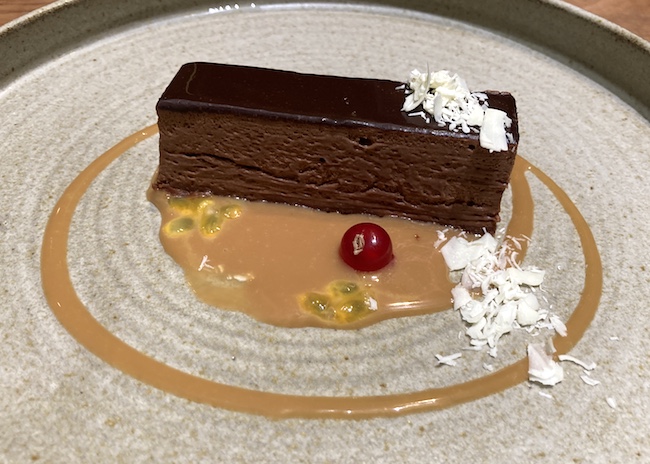 Dessert is chocolate mousse with hazelnuts and a passionfruit caramel sauce. Dreamy is the word that comes to mind. After an espresso—why not live on the wild side?—I take a glass of Fernet Branca up to my room. And sleep very well.
Dessert is chocolate mousse with hazelnuts and a passionfruit caramel sauce. Dreamy is the word that comes to mind. After an espresso—why not live on the wild side?—I take a glass of Fernet Branca up to my room. And sleep very well.
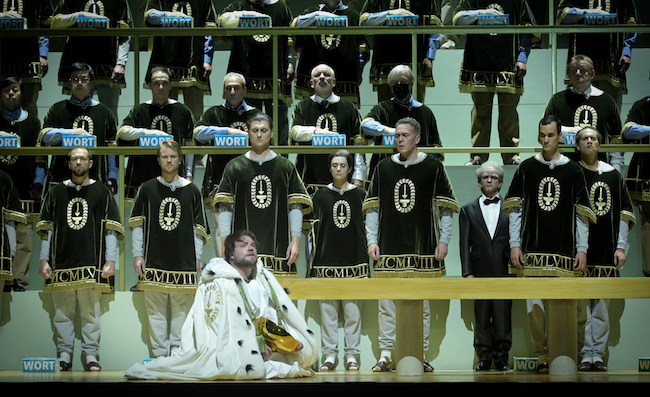
by Christina Waters | Jul 6, 2022 | Home |
Parsifal: Twilight of a Production
Having traveled 5000 miles to dive into the Opera Bastille production of Wagner’s final opera, I was poised for a memorable experience. And while I certainly got one, it was mostly for the wrong reasons.
Here’s the short version.
Conducted by Wagner veteran, Simone Young, the Paris Opera gave a fine reading of music so romantically breathtaking that it defines “sublime.” Excellent throughout, the orchestra managed to hold out against a mesmerizing yet ultimately destructive production, perpetrated by director Richard Jones. The elaborate set, moving on invisible tracks to reveal ever more chambers and levels, was clever, ludicrous, puzzling, and silly.
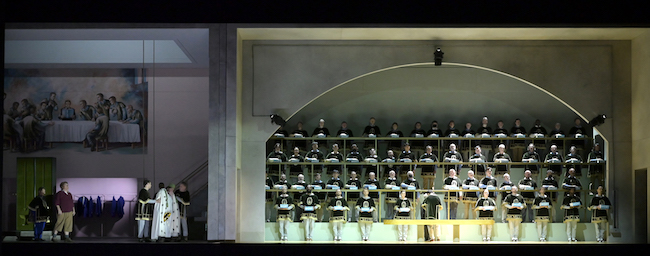
The costumes were blatantly ugly, and while we don’t always expect singers who are svelte, or who are also good actors, we could hope for more than the baggy shorts, backpacks, and sweatshirts most of the principals had to endure. Also terrible—save for the stalwart Kwangchul Youn as Gurnemanz, and Falk Struckmann as Klingsor—the singers had their eyes glued on the conductor for most of the performance.
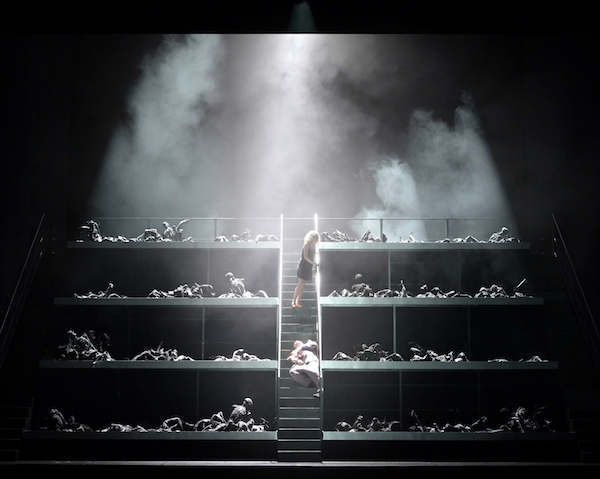
photo: Vincent PONTET
The chorus was wonderful. And even though the music simply cannot be ruined, the production design tried its hardest to cut deeply into Wagner’s spiritual vision. Trashing the concept of Parsifal’s innocence overcoming magician Klingsor’s malevolent genetic engineering, the Act 2 Set of lusty flowermaidens jiggling fake boobs and buns non-stop, was tiresome. This four-year-old production felt distinctly dated.
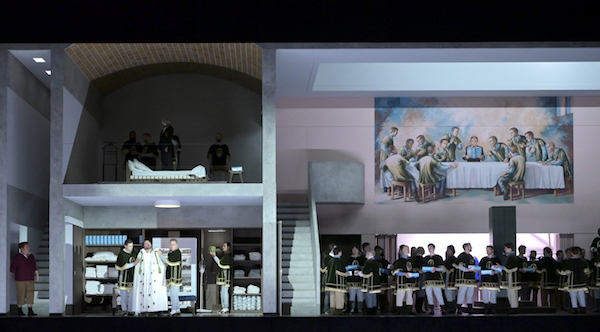
Nothing this production threw at the audience did anything to illuminate new vistas, or unprobed corners of this complex work of art. The final act was inexcusably boring. Three people, standing around on a nearly bare stage, singing at each other (and none too well) for over an hour.

Now for the longer version.
Conductor Simone Young moved the Paris Opera orchestra smoothly through the depths of Wagner’s final opera, the entire ensemble firmly in her eloquent hands.
The underlying spirituality of the composer’s great music-drama “consecration” came through clearly, despite the visual antagonism of an agnostic setting and shallow visual interpretation.The point is made clearly by the great horn motifs and ascending chromatics of chord structure, the rising colors of the sound as if sunlight suddenly thrusts through the rose window of a great cathedral. Music and setting contradicting each other whenever possible.
As the opera moves us through an often incomprehensible maze of myths, metaphors, and magic, the composer summarizes his own repertoire, unafraid to quote his own work, to borrow from his own splendid musical themes.
While contemporary, even futuristic visual settings are often effective in reinforcing the romantic timelessness of the story, in the case of Richard Jones’ concept quite the opposite is true. The clever but overwrought transplantation of the story into future of cultish monasticism fail to move our understanding any further. The flower maidens as GMO-creations of exhaustingly explicit sexuality—less would have been more. The elision of sports cults and religious fanaticism, while perhaps persuasive, again didn’t illuminate the overall genius of this last work of the great master.
For that, we had the music itself.
Here’s the best place to focus on the complex set, which moved laterally to reveal ever more chambers, and in some scenes multiple levels. An arresting illustration of the opera’s mythic words: “here Time becomes Space.” From the study hall of what appears to be a cult devoted to “the Word,” the set moved the actors into austere chambers containing the bleeding Gail lord Amfortas and in a small bedroom upstairs, the dying founder of the Grail knights, Tintural. As the set continued to expand, it revealed a conference room crowned by a mural of a proto-Last Supper, and finally into a huge sports arena lined with row after row of cult followers (the mighty Paris Opera choir, flawlessly trained by choral director Ching-Lien Wu).
Calling lots of attention to itself, the set was alternately effective and silly, inspired and stupid. This production by Richard Jones feels smug about itself, the clever set as visual tour de force, with robotic cult members whose movements have been honed to within a goose step. And yet without the rapture implied by the chromatically mutating music, the entire production comes off as ironic and sterile.
The complete opposite of the semi-staged Ring I went on to see in Budapest, where minimal staging allowed the music and voices to cast their spells with emotional intimacy, the Paris Parsifal felt robotic, overwhelmed, and tired. Hopefully it will be retired for something fresh. Perhaps something that has more to do with the music, and less with the sort of fashionable revisioning that can completely undercut the musical ideas. The Frank Castorf Ring in 2013 comes to mind. Or the Sebastian Baumgarten Tannhäuser in which grotesque romping monsters obliterated some of the most gorgeous music ever composed.
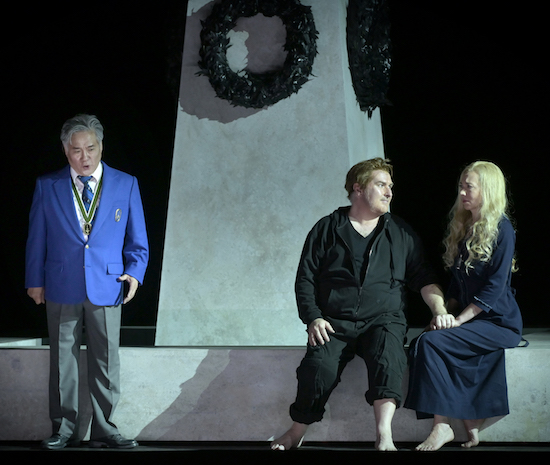
Photo : Vincent PONTET
In warmup suits as if about to attend a sports contest—the Paris Open perhaps?—the old faithful knight of the Grail, Gurnemanz, was given stalwart voice by Parsifal veteran Kwangchul Youn. I’d heard him in the 2014 Bayreuth production in the same role, and his resounding and tireless musicality seemed not to have aged. As the wounded Grail lord Amfortas, Iain Paterson looked and sounded exhausted. As the pure fool, Parsifal, Simon O’Neill relied on almost non-stop eye contact with conductor Young as if uncertain what his next lines should be. The mercurial time-traveling witch Kundry, dressed in hipster backpack and sweatshirt sung by Russian mezzo-soprano Marina Prudenskaya, was neither believable nor vocally engaging. By the end of the opera, she had devolved from temptress to penitent, and then finally as best buddy to the hero with whom she sauntered off-stage hand-in-hand. In Wagner’s original version, Parsifal absolves her wickedness and she gratefully swoons and dies.
The last act, incomprehensibly sung against a bare stage, is inexcusably boring. Why have the newly repentant witch Kundry, and the newly awakened Parsifal, explain their realizations in a completely empty space? Vocal precision and color might have helped. But these were alas also missing.
Would that this bewildering yet majestic music had been sung by brilliant voices. As it was, the June 6 performance left me longing to have heard the 2018 debut version of this production, with the acting genius Peter Mattei as Amfortas, heldentenor Andreas Shager as Parsifal, and the rich and adroit mezzo of Anja Kampe as Kundry. The veteran Wagnerian Falk Struckmann, as the malevolent magician Klingsor, announced through a spokesman at the start of the opera that he was not in his best form that night. My heart almost stopped. I’d been a fan since I saw him as Hagen in the Vienna Ring five years ago. A savvy actor, Struckmann performed nonetheless and even in less than perfect form he sounded better than most of the others on that stage.
The costume designer owes an apology to singers and audience Baggy clothing on Parsifal, fussy and dowdy costumes on Kundry, woefully malfunctioning fake blood on the robes of Amfortas, and the hilarious X-rated gyrations of the genetically engineered maize maidens made this Parsifal a pleasure only if you closed your eyes.
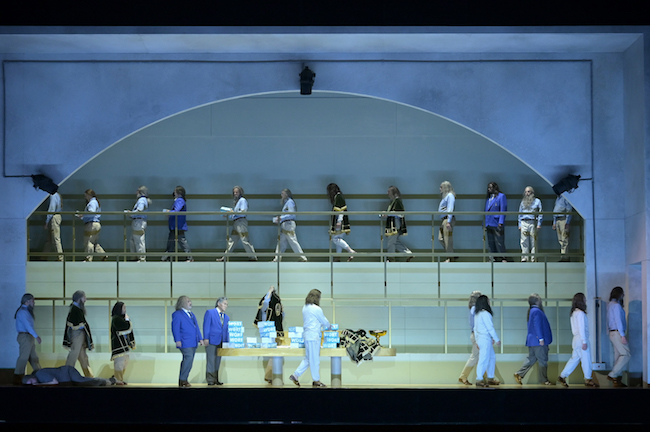
The ascending fifths of the Dresden Amen still worked their redemptive magic, and while this production makes almost nothing of the spiritual thrust of this opera, the splendid orchestra rose to the occasion. It made sense of philosopher Friedrich Nietzsche’s confession that while he loathed the Christian theme underlying Parsifal, he had to admit the music was sublime. Sublime and worth the five hours and 5000 miles I’d traveled to enjoy.
Orchestre de l’Opéra national de Paris

by Christina Waters | Jul 6, 2022 | Home |
I’d waited for almost three years to get on a plane headed for Europe. And Paris did not disappoint. Balmy summer weather, baguettes as good as my memories, and a few days to kill roaming the city, and some great museums before my night at the opera—Parsifal—arrived.
The light rain falling as we drove into the city from Charles de Gaulle announced that I wasn’t in California anymore. Warm temperatures, day and night, noticeble humidity plus the long days of summer—sunset not until 10pm—felt especially welcoming. From my embarrassingly posh hotel across the street from the Louvre, I was able to explore a few bistros, shops, and of course the reassuring sight of Notre Dame, still splendid even surrounded by cranes and fencing.

One dinner at Paul Bocuse’s Hotel Louvre Restaurant, provided me with an impeccable Scottish salmon on a bed of potatoes, giant capers, and hazelnuts. Paired with the sort of bread that dreams are made of, and a glass of crisp Chablis, it answered a craving that had built up for several years of quarantine.
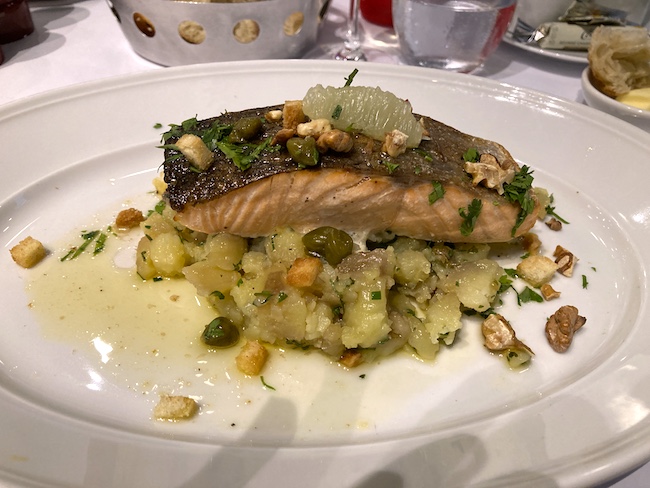 Next morning, reserved ticket in hand (or rather on my phone) I was ushered into a very short line (three people!) into the vastness of the Louvre. Avoiding the crowded line encircling the Mona Lisa, I instead re-visited a few of my favorite paintings, including a Mantegna that might have been painted yesterday, the miraculous Virgin of the Rocks, and rediscovered the genius of Jean-Louis David.
Next morning, reserved ticket in hand (or rather on my phone) I was ushered into a very short line (three people!) into the vastness of the Louvre. Avoiding the crowded line encircling the Mona Lisa, I instead re-visited a few of my favorite paintings, including a Mantegna that might have been painted yesterday, the miraculous Virgin of the Rocks, and rediscovered the genius of Jean-Louis David.
 I devoured as much as I could before visual saturation set in and it was time to head up the street to Bistrot Victoires for a delicious duck confit with perfect potatoes and a glass of Côtes du Rhône.
I devoured as much as I could before visual saturation set in and it was time to head up the street to Bistrot Victoires for a delicious duck confit with perfect potatoes and a glass of Côtes du Rhône.
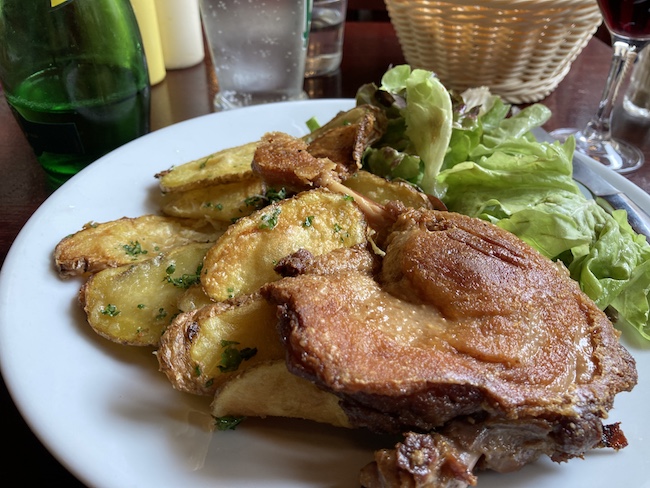 Followed by an espresso, the lunch confirmed my belief in Paris as a city of high culinary standards.
Followed by an espresso, the lunch confirmed my belief in Paris as a city of high culinary standards.
Next day, I sprinted across the Pont du Carousel to the Musée d’Orsay and a mini-orgy of 19th and 20th century artwork, distinguished by new and old Manets, a few choice van Goghs, and an array of gleaming Art Nouveau furniture, rugs, and candelabra.

Again, I tried to make sure I left before eye-stupor set in. I strolled up to the St. Germain neighborhood, and had an espresso at Les Deux Magots in honor of Jean-Paul Sartre and Simone de Beauvoir who often spent time smoking, drinking, and writing at this very cafe.
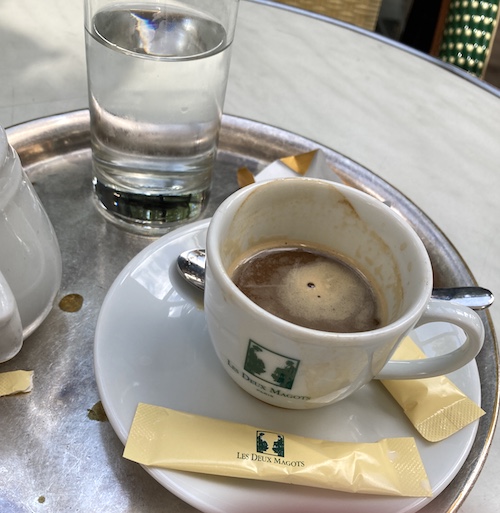 That evening, I walked across the river again to the exquisite Gothic jewelbox that is Saint Chapelle, built by St. Louis to house his splinter of the True Cross, and enjoyed the rare experience of an intimate concert of piano music by the heroic performer Vanessa Wagner, a woman with Bronzino arms and complete command of her instrument.
That evening, I walked across the river again to the exquisite Gothic jewelbox that is Saint Chapelle, built by St. Louis to house his splinter of the True Cross, and enjoyed the rare experience of an intimate concert of piano music by the heroic performer Vanessa Wagner, a woman with Bronzino arms and complete command of her instrument.
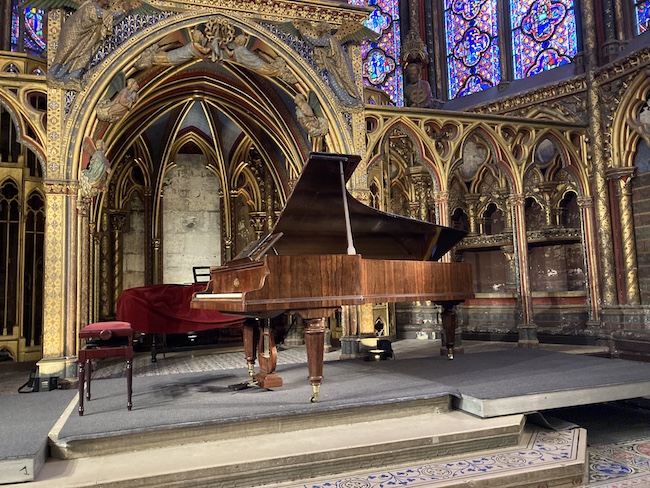 Only two hundred seats in the tiny upper sanctuary, still light enough at 8pm for sun to illuminate the incredible stained glass, as we listened to Mozart, Rachmaninoff, and Debussy. Acoustics as impeccable as the interior itself.
Only two hundred seats in the tiny upper sanctuary, still light enough at 8pm for sun to illuminate the incredible stained glass, as we listened to Mozart, Rachmaninoff, and Debussy. Acoustics as impeccable as the interior itself.
I sat outside on the patio of my hotel Palais Royal, with a Campari spritz, and enjoyed the feel of the soft heavy air on my face and arms. Parisians are a hundred times more diverse than we are in California, and the procession of colors and costumes, fashions and follies was almost as delicious as the cuisine.
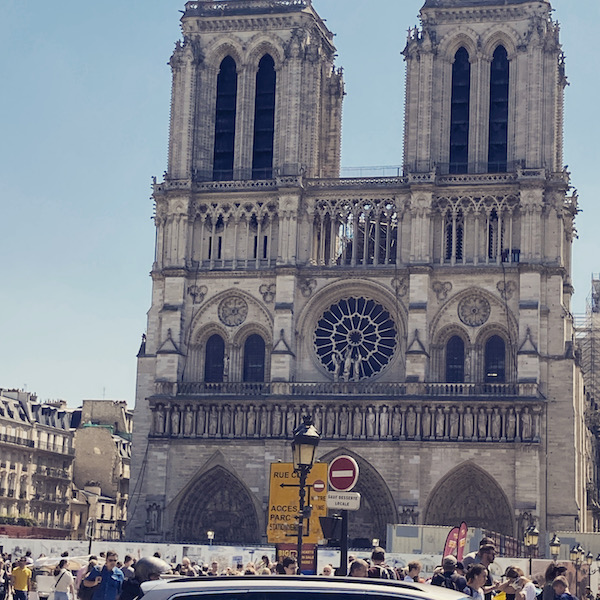
The next evening was my night at the opera, so I enjoyed a Croque Monsieur and pommes frites at the nearby Cafe Blanc before heading out to the Opera Bastille, where I would consume only a glass of champagne and a ham and cheese sandwich during the next five hours and 15 minutes. [see my account of the opera itself in an adjoining post]
My last day in Paris I wandered through the renovated Art Nouveau interior of the enormous upscale Samaritaine department store. Then it was back to my neighborhood to the 2-star Michelin restaurant Palais Royal, where I had a long-awaited lunch reservation. Three courses, prix fixe, plus a glass of the kind of Bordeaux that makes you want to rob a bank.
Palais Royal and the handiwork of chef Philip Chronopoulos.
Armed with a pedigree that has taken him to London, Paris, and soon Venice, this chef sets an inventive tone. The room was simple, perfect, not fussy. The very young staff spoke English well, and unlike Parisian dining of yore, they smiled and made each diner feel comfortable—from the table filled with expense account businessmen to me, a solo diner splurging on what would be a memorable succession of gorgeous dishes.
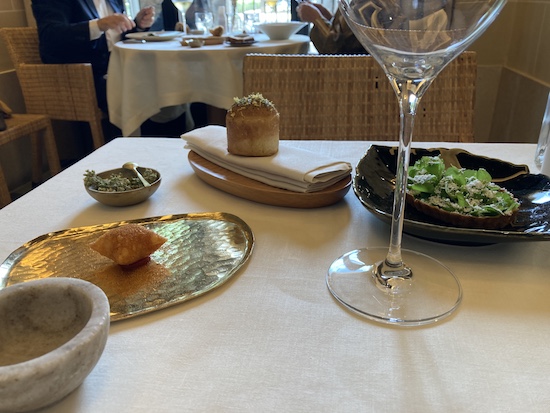 The initial amuses dishes included a single deep-fried pastry pillow filled with a warm quail egg yolk. A little pastry boat filled with fresh pea puree, topped with a tangle of mâche and parmesan. A pretty salad of warm grapes and tiny beets arrived topped with a scoop of creamy feta in a pool of sweet and salty broth. And an incredible cheese straw (much more elegant than that) but essentially a finger of crisp cheese filled with veloté of foie gras—it was one of the best things I’ve ever tasted.[see below]
The initial amuses dishes included a single deep-fried pastry pillow filled with a warm quail egg yolk. A little pastry boat filled with fresh pea puree, topped with a tangle of mâche and parmesan. A pretty salad of warm grapes and tiny beets arrived topped with a scoop of creamy feta in a pool of sweet and salty broth. And an incredible cheese straw (much more elegant than that) but essentially a finger of crisp cheese filled with veloté of foie gras—it was one of the best things I’ve ever tasted.[see below]
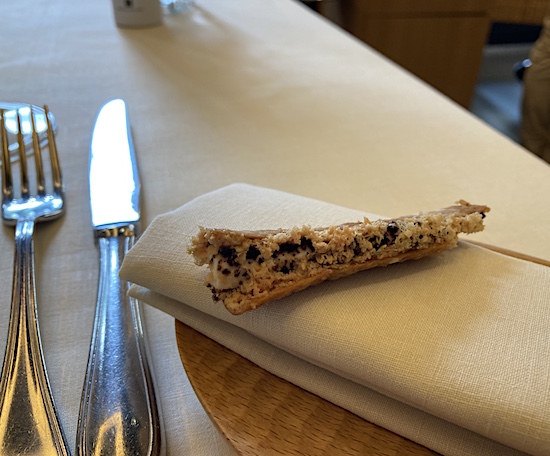 And a miniature brioche topped with micro-zest of lemon. Plus two breads, arriving with a bowl of olive oil and another bowl of aromatic oregano. One flavor is intended to enhance its partner, you combine them as you like.
And a miniature brioche topped with micro-zest of lemon. Plus two breads, arriving with a bowl of olive oil and another bowl of aromatic oregano. One flavor is intended to enhance its partner, you combine them as you like.
 Then came a plate of gamba, a large prawn, sided by two basil-tinged green gnocchi draped with calamari crudo, plus a flash fried zucchini flower, on a little hill of broccolini. The gnocchi each sat on a brilliant green sauce of basil. This dish justified the entire trip to Paris.
Then came a plate of gamba, a large prawn, sided by two basil-tinged green gnocchi draped with calamari crudo, plus a flash fried zucchini flower, on a little hill of broccolini. The gnocchi each sat on a brilliant green sauce of basil. This dish justified the entire trip to Paris.
All flavors were robust yet unmuddied. Each ingredient made sense of the others, showing the chef’s intuitive understanding of how the dish would unfold as a process, rather than single creation of flavors combined in the kitchen. The center of the meal was a plate of duck encircled by warm cherries and a cherry mustard balsamic reduction. Adorned with tiny onion flowers. Yes it was terrific. But not as terrific as my dessert.
 Arriving in two dishes was what amounted to a deconstructed tiramisu. As with all of this chef’s dishes, the dessert was intended to be enjoyed as a sequence, or layering of flavors.
Arriving in two dishes was what amounted to a deconstructed tiramisu. As with all of this chef’s dishes, the dessert was intended to be enjoyed as a sequence, or layering of flavors.
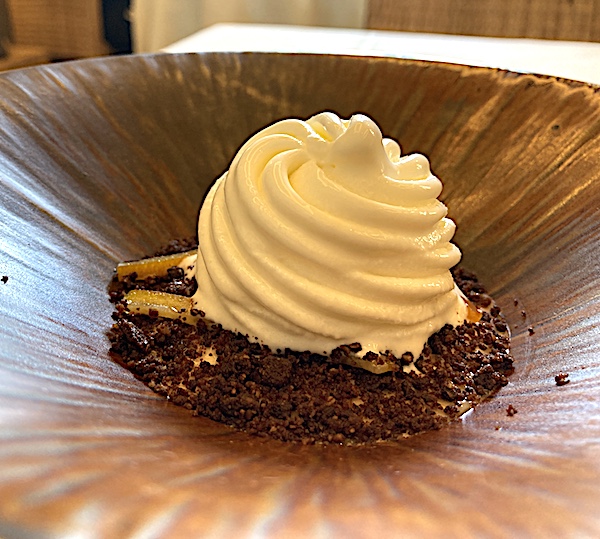 Mascarpone ice cream in one dish, candied orange peel on the side, and a warm baba drenched in rum on a crust of coffee nibs. Creme Chantilly on top was dusted with a veil of cacao and unidentifiable spices. I ate every bite. Finished with an espresso.
Mascarpone ice cream in one dish, candied orange peel on the side, and a warm baba drenched in rum on a crust of coffee nibs. Creme Chantilly on top was dusted with a veil of cacao and unidentifiable spices. I ate every bite. Finished with an espresso.
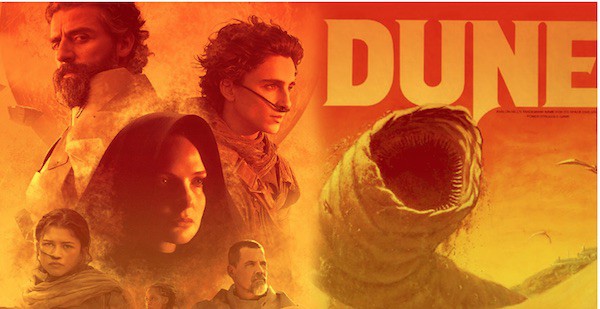
by Christina Waters | Nov 15, 2021 | Home, Movies |
Before I get down to serious ripping and shredding, I need to get this off my chest.
As a baby boomer, I read and thrilled to Frank Herbert‘s prescient, imaginative, and mythic futuristic novel. Canadian director Denis Villeneuve, of murky self-important Arrival fame, has taken it upon himself to launch an almost-three hour cinema version of Dune. This was an error of epic proportions. The badness of this film is the only thing close to epic in this exercise of cine-waste so awful, so clueless, so dis-inspired as to defy reason.

Villeneuve’s Dune is also murky, lethargic, impenetrable, and boring. What he has done to a seminal text should be illegal, like using the Holy Grail as a jello mold. All I could think, as I reeled out of the theater on a salt high, thanks to over-priced movie popcorn, was: how could I get back those three hours of my life?
Grab a sharp stick, aim it squarely at your left eye (or right, whatever you like) and stab! You will thus experience a more pleasurable sensation than that delivered by the clueless Canadian and his unpleasant cast.
Okay.
Now I can begin. I’ll start with the most egregious error made by this bloated production team: casting. It’s hard to recall casting this misguided, even hilarious, since that big blonde gentile Charlton Heston sauntered down the mountain with stone tablets in The Ten Commandments.
Starting with the worst: wasp-waisted Timothee Chalamet as the fierce, psychicically gifted messianic avatar Paul Atriedes. Chalamet would be fine in a bio-pic playing the young Oscar Wilde. Ideally in a film without any speaking parts. Chalamet was wretched as well as utterly unbelievable as the heir apparent to a powerful royal dynasty as well as leader of the new eco-desert utopia on Arakis. Yet, there might be five minutes of this almost 3-hour film in which the anorexic teen idol does not appear. He is so not up to the task that his mere presence inspires fantasies of the merely awful Kyle MacLachlen in David Lynch’s lackluster attempt to bring Dune to the screen 40 years earlier.
Maybe worse is the presence of Oscar Isaac. His mere presence on-screen is cause for genuine alarm, but to watch him attempt something like gravitas as Paul’s ill-fated father Duke Leto Atriedes is akin to enduring a three-hour root canal procedure. Does no one understand the importance of vocal power and nuance in filmmaking these days?
Rebecca Ferguson as Paul’s mother, the supernaturally trained Lady Jessica who teaches her son the special powers of her psychic order the Bene Gesserit, has an appropriately intelligent voice. We believe that she believes what she’s saying. Yet she, as all the others, is sabotaged again and again by a silly script.
And Josh Brolin as the adroit, amiable fight master Gurney Halleck? Not bloody likely. Brolin, with his Marine haircut and fatigues, looks like he stepped out of another film, and another timeline. He should have checked in with his acting coach before filming. So should Sharon Duncan-Brewster, who looks great as the double agent Shadout Mapes, but again, appears to have no working knowledge of the script, its language (English), or its meaning.
Another who needs slapping around is the once great Javier Bardem, a wooden cartoon of the mighty warrior of the desert tribe, the Fremen. All I could think of was Anthony Quinn as the Bedouin leader in Lawrence of Arabia. Quinn was more believable.
Here I’ll circle back on poor matinee-idol-du-jour Chalamet, who is burning through his fifteen minutes like an addict through fentanyl. So physically wraith-like and awkward as to mock the idea that he could match knives with the Fremen soldier who calls him out, Chalamet appears not to understand or care what he is doing. Indeed, he appears embarrassed to be in front of the camera, especially given the lingering closeups he has to endure. Is he Villeneuve’s fantasy boy?
I’m too exhausted to continue.
My next installment of Dune demolition will involve asking whether ponderous camerawork, massive explosions and a behemoth score can actually substitute for a script, dramatic tension, excitement, inspiration, and/or (god help us) acting.
to be continued…..
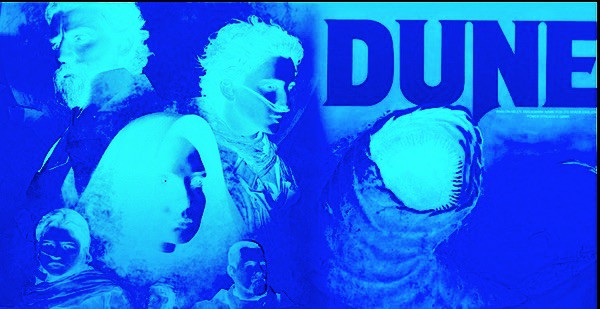
Desert Bomb: Part II
by Christina Waters | Nov 14, 2021 | Movies |
Just thinking about continuing my assessment of Denis Villeneuve’s bloated bomb makes me reach for the gin. You’ll recall I decided to address whether ponderous camerawork, massive explosions and a behemoth score can actually substitute for a script, dramatic tension, excitement, inspiration, and/or (god help us) acting.
Courage!
Rarely has so much money been thrown at such an empty concept for remaking an earlier semi-bomb. At least the original 1984 Dune had a certified genius—David Lynch—sinking the ship.
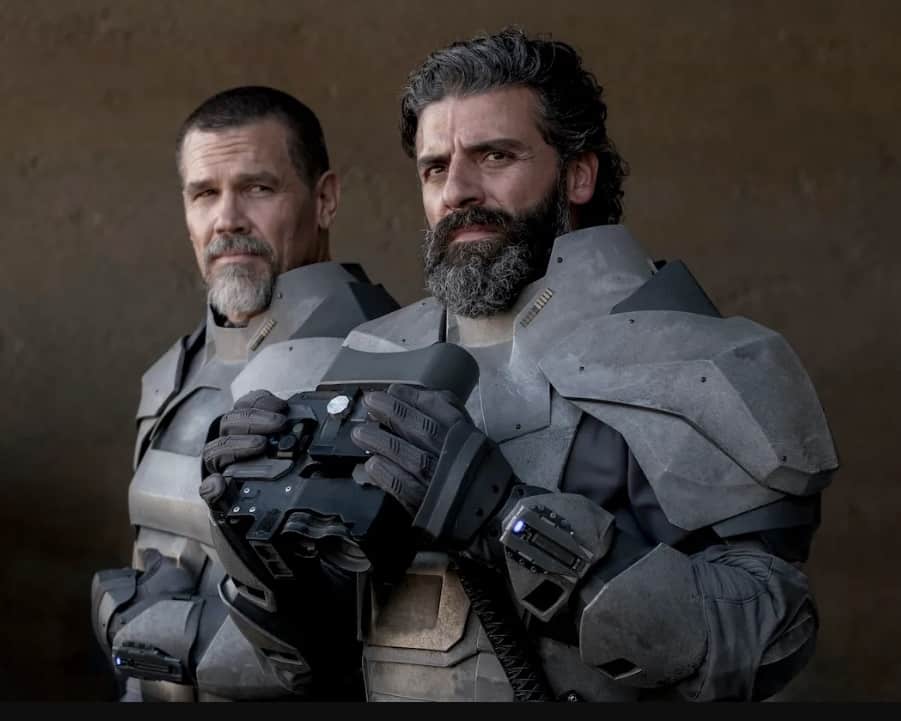
Uniforms like these aluminum foil origami jumpsuits, [see above shot of special-needs actor Josh Brolin posing next to self-important actor Oscar Isaac] made me nostalgic for the spectacle of Kyle MacLachlan fighting uber-hunk Sting in the original cinematic Dune.
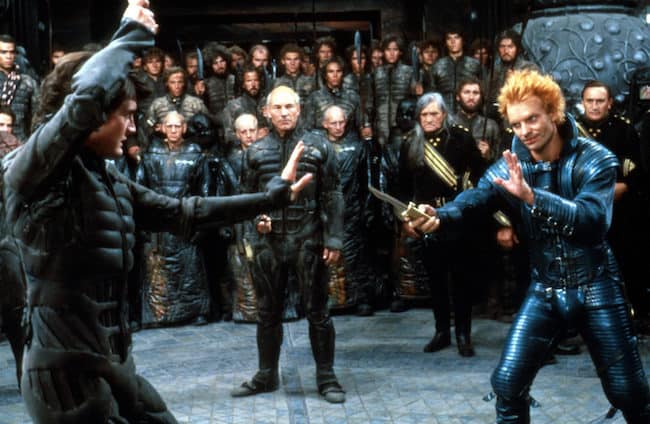
But onward! Visuals: Shall we begin by asking how many Architectural Digest decorators it took to polish the concrete fortress walls of the House of Atreides? Tunnels of grey, leading to rooms of grey, occasionally occupied by individuals in grey. I’ve seen bus station waiting rooms with more style than the royal chambers of our central figures. The camera obsesses over the acreage of grey that forms the central heart of this lumbering film.
Maybe the interiors were designed by fashion people, you know, Prada, or Chanel, or Alexander McQueen so that when the female actors glide from one grey hall to another, we could admire the way their diaphanous robes billow in the wind machine airflow. Yes. That must have been the thinking behind the cavernous, dark interiors. Catwalks of the future. [Note the post-Taliban exoskeletons in which our principals are dressed for desert life.]
And how about the decision to have big guy Jason Momoa, playing the wiley Duncan Idaho, do his acting entirely with his eyebrows! Ugh.
How about long, self-indulgent camera shots? The Valium-scented overhead shots, the countless drone shots, the shots designed to substitute for the missing: A) script, B) insight, C), narrative arc, or D) dramatic tension. No worries. Just keep the camera rolling, tack on an extra half hour, and gamble that the Cannes crowd will eat it up.

Another secret of Villeneuve’s concept: no editing. Just take after take after take. Again for reasons noted above: keep viewers off-balance so they won’t notice the vacuity of the cinematic text.
And throw in many explosions. Explosions requiring loud booms. Here the visual barrage meets the sonic barrage.
Score: And that brings me to the once-notable Hans Zimmer, composer for Gladiator, The Lion King, Inception, and a few others. In this film, Zimmer’s mega-decible score does most of the heavy lifting, drama-wise. During the final, interminable, 45 minutes of Dune (the one with teen throb Timothee Chalamet ((don’t get me started on the pretentious spelling of his name!))), Zimmer’s score IS the film. This device of making the sound do the work is cheap and obvious. Villeneuve ran out of ideas very early on, even though Frank Herbert (the book’s author) provided plenty of them. So he just cranked up Zimmer’s score, threw in explosions and Bob’s your uncle.
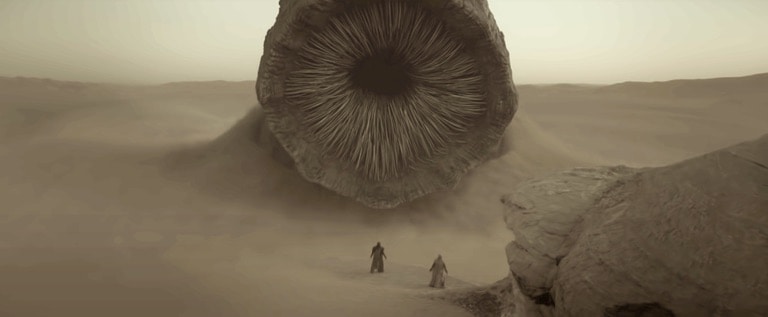
Loud. Very loud. And when the film still fails to revive movie-goers who have by now fallen into comas unalleviated by either popcorn or diet Cokes, Zimmer & company simply make everything louder.
And slow. Slow sand. Slow explosions. Slow loud music.
Let’s review: Dune is a book of eco prophecy, laced with compelling mythology, labyrinthean power conflicts, inventive sorcery and mysticism set in the heart of a desert scented by spice. And not just any spice. Spice that allows the consumer to intuit thoughts, feelings, and events both intimate and far into the future. At the center of this story is a young man who, thanks to his mother’s power and clairvoyance has been bred to exist in many temporal states at once. Yes my friends, long before Keanu Reeves, Paul Atriedes was The One. And no my friends, Timothée (pretentious spelling) Chalamet, is NOT The One.
Spend a more pleasant two and a half hours filling out tax forms, or calling AT&T Customer Service and waiting on hold to a continuous loop of Vivaldi’s Four Seasons.
Caveat Emptor! and if there is a god, Villeneuve will find himself without the funding to continue his cruel dismantling of Dune.


 I too succumbed to an irresistible Chicken Paprikish with galuszkaval….little noodlelike dumplings. The dish arrived steaming hot, utterly delicious. Homey chicken stew liberally perfumed with paprika, and the noodles were the ultimate comfort food. The temperature in the shade was at least 85 degrees so my lunch was consumed with a large bottle of mineral water. The couple to my right worked their way through enormous bowls of ice cream, sauced with chocolate and fruit, and topped with whipped cream. Bowls the size of children’s wading pools. They finished everything.
I too succumbed to an irresistible Chicken Paprikish with galuszkaval….little noodlelike dumplings. The dish arrived steaming hot, utterly delicious. Homey chicken stew liberally perfumed with paprika, and the noodles were the ultimate comfort food. The temperature in the shade was at least 85 degrees so my lunch was consumed with a large bottle of mineral water. The couple to my right worked their way through enormous bowls of ice cream, sauced with chocolate and fruit, and topped with whipped cream. Bowls the size of children’s wading pools. They finished everything. The courses, all wonderful, begin with delightful amuses. A warm kumquat arrives filled with pureed kumquat. A granita of citrus and Campari comes topped with carrot foam. A baby green leaf is flash fried. The bread is so good I could cry. An oat-based ciabatta, it arrives with a fist full of soft French butter that has been oak-smoked and topped with (so help me) Hawaiian charcoal. The effect is of a hint of smoke and intensely mineral/salt finish. This is bread that can actually hold its own with my fresh memories of French baguettes.
The courses, all wonderful, begin with delightful amuses. A warm kumquat arrives filled with pureed kumquat. A granita of citrus and Campari comes topped with carrot foam. A baby green leaf is flash fried. The bread is so good I could cry. An oat-based ciabatta, it arrives with a fist full of soft French butter that has been oak-smoked and topped with (so help me) Hawaiian charcoal. The effect is of a hint of smoke and intensely mineral/salt finish. This is bread that can actually hold its own with my fresh memories of French baguettes.
 Another starter of grapefruit, with fresh tarragon on a shallow lake of pistachio cream is a surprise and a knock-out.
Another starter of grapefruit, with fresh tarragon on a shallow lake of pistachio cream is a surprise and a knock-out. The main course of aged Hungarian beef is served with a splendid cabernet franc offering ample tannins. A little salad on the side is topped with glistening salmon caviar and cornichons. The surrounding sauce is bright with citrus, chiles, sesame, truffle foam and roast potatoes.
The main course of aged Hungarian beef is served with a splendid cabernet franc offering ample tannins. A little salad on the side is topped with glistening salmon caviar and cornichons. The surrounding sauce is bright with citrus, chiles, sesame, truffle foam and roast potatoes. Dessert is chocolate mousse with hazelnuts and a passionfruit caramel sauce. Dreamy is the word that comes to mind. After an espresso—why not live on the wild side?—I take a glass of Fernet Branca up to my room. And sleep very well.
Dessert is chocolate mousse with hazelnuts and a passionfruit caramel sauce. Dreamy is the word that comes to mind. After an espresso—why not live on the wild side?—I take a glass of Fernet Branca up to my room. And sleep very well.









 Next morning, reserved ticket in hand (or rather on my phone) I was ushered into a very short line (three people!) into the vastness of the Louvre. Avoiding the crowded line encircling the Mona Lisa, I instead re-visited a few of my favorite paintings, including a Mantegna that might have been painted yesterday, the miraculous Virgin of the Rocks, and rediscovered the genius of Jean-Louis David.
Next morning, reserved ticket in hand (or rather on my phone) I was ushered into a very short line (three people!) into the vastness of the Louvre. Avoiding the crowded line encircling the Mona Lisa, I instead re-visited a few of my favorite paintings, including a Mantegna that might have been painted yesterday, the miraculous Virgin of the Rocks, and rediscovered the genius of Jean-Louis David. I devoured as much as I could before visual saturation set in and it was time to head up the street to Bistrot Victoires for a delicious duck confit with perfect potatoes and a glass of Côtes du Rhône.
I devoured as much as I could before visual saturation set in and it was time to head up the street to Bistrot Victoires for a delicious duck confit with perfect potatoes and a glass of Côtes du Rhône. Followed by an espresso, the lunch confirmed my belief in Paris as a city of high culinary standards.
Followed by an espresso, the lunch confirmed my belief in Paris as a city of high culinary standards.
 That evening, I walked across the river again to the exquisite Gothic jewelbox that is Saint Chapelle, built by St. Louis to house his splinter of the True Cross, and enjoyed the rare experience of an intimate concert of piano music by the heroic performer Vanessa Wagner, a woman with Bronzino arms and complete command of her instrument.
That evening, I walked across the river again to the exquisite Gothic jewelbox that is Saint Chapelle, built by St. Louis to house his splinter of the True Cross, and enjoyed the rare experience of an intimate concert of piano music by the heroic performer Vanessa Wagner, a woman with Bronzino arms and complete command of her instrument. Only two hundred seats in the tiny upper sanctuary, still light enough at 8pm for sun to illuminate the incredible stained glass, as we listened to Mozart, Rachmaninoff, and Debussy. Acoustics as impeccable as the interior itself.
Only two hundred seats in the tiny upper sanctuary, still light enough at 8pm for sun to illuminate the incredible stained glass, as we listened to Mozart, Rachmaninoff, and Debussy. Acoustics as impeccable as the interior itself.
 The initial amuses dishes included a single deep-fried pastry pillow filled with a warm quail egg yolk. A little pastry boat filled with fresh pea puree, topped with a tangle of mâche and parmesan. A pretty salad of warm grapes and tiny beets arrived topped with a scoop of creamy feta in a pool of sweet and salty broth. And an incredible cheese straw (much more elegant than that) but essentially a finger of crisp cheese filled with veloté of foie gras—it was one of the best things I’ve ever tasted.[see below]
The initial amuses dishes included a single deep-fried pastry pillow filled with a warm quail egg yolk. A little pastry boat filled with fresh pea puree, topped with a tangle of mâche and parmesan. A pretty salad of warm grapes and tiny beets arrived topped with a scoop of creamy feta in a pool of sweet and salty broth. And an incredible cheese straw (much more elegant than that) but essentially a finger of crisp cheese filled with veloté of foie gras—it was one of the best things I’ve ever tasted.[see below] And a miniature brioche topped with micro-zest of lemon. Plus two breads, arriving with a bowl of olive oil and another bowl of aromatic oregano. One flavor is intended to enhance its partner, you combine them as you like.
And a miniature brioche topped with micro-zest of lemon. Plus two breads, arriving with a bowl of olive oil and another bowl of aromatic oregano. One flavor is intended to enhance its partner, you combine them as you like. Then came a plate of gamba, a large prawn, sided by two basil-tinged green gnocchi draped with calamari crudo, plus a flash fried zucchini flower, on a little hill of broccolini. The gnocchi each sat on a brilliant green sauce of basil. This dish justified the entire trip to Paris.
Then came a plate of gamba, a large prawn, sided by two basil-tinged green gnocchi draped with calamari crudo, plus a flash fried zucchini flower, on a little hill of broccolini. The gnocchi each sat on a brilliant green sauce of basil. This dish justified the entire trip to Paris. Arriving in two dishes was what amounted to a deconstructed tiramisu. As with all of this chef’s dishes, the dessert was intended to be enjoyed as a sequence, or layering of flavors.
Arriving in two dishes was what amounted to a deconstructed tiramisu. As with all of this chef’s dishes, the dessert was intended to be enjoyed as a sequence, or layering of flavors. Mascarpone ice cream in one dish, candied orange peel on the side, and a warm baba drenched in rum on a crust of coffee nibs. Creme Chantilly on top was dusted with a veil of cacao and unidentifiable spices. I ate every bite. Finished with an espresso.
Mascarpone ice cream in one dish, candied orange peel on the side, and a warm baba drenched in rum on a crust of coffee nibs. Creme Chantilly on top was dusted with a veil of cacao and unidentifiable spices. I ate every bite. Finished with an espresso.






